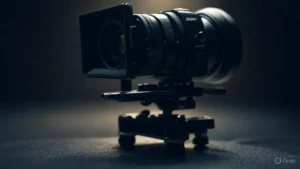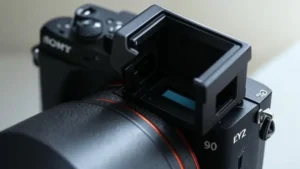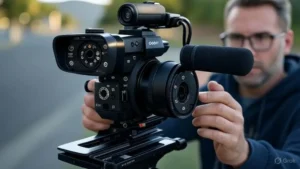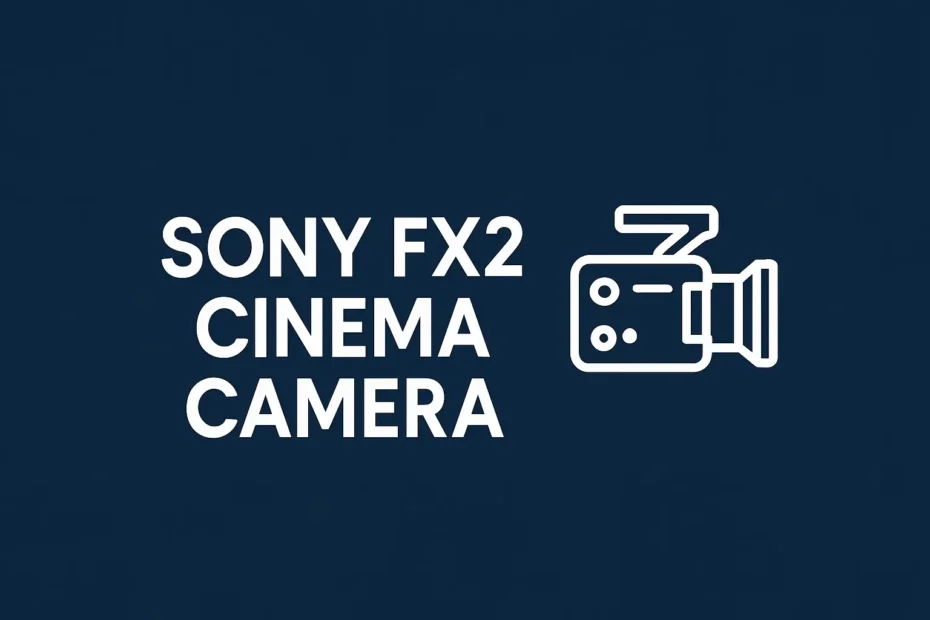In Sony’s relentless pursuit of cinematic innovation, the Cinema Line FX2 emerges not as a revolutionary leap, but as a calculated evolution that perfectly balances professional video capabilities with unprecedented stills performance. Positioned strategically between the popular FX3 and FX30 models, this $2,699 full-frame powerhouse (body only) represents Sony’s acknowledgment of the growing hybrid creator economy. Announced in May 2025 with August availability, the FX2 answers filmmaker demands for a more versatile tool that bridges the gap between traditional cinema cameras and hybrid mirrorless systems – all while introducing the industry’s first tiltable electronic viewfinder in this category.

Why the FX2 Matters Now
The timing of the FX2’s release speaks volumes about shifting market demands. As content creation spans vertical social media, documentary filmmaking, and commercial photography, professionals need tools that adapt across formats without compromise. The FX2 delivers precisely this versatility, packing a 33MP full-frame Exmor R CMOS sensor inherited from Sony’s acclaimed a7 IV, but rehoused in a video-optimized Cinema Line body with professional audio capabilities and revolutionary cooling technology that enables marathon 13-hour recording sessions in 4K 60p 2514. This isn’t just another camera – it’s a statement about the future of content creation.
Technical Specifications at a Glance
-
Sensor: 33MP Full-Frame Exmor R BSI CMOS
-
Processor: BIONZ XR
-
Video: 7K Oversampled 4K up to 30p, 4K 60p (APS-C crop), FHD 120p
-
Codecs: 4:2:2 10-bit XAVC S-I All-I, H.265, 16-bit RAW HDMI output
-
Base ISO: Dual Native ISO 800/4000 (S-Log3)
-
Dynamic Range: 15+ stops (Sony claimed)
-
Stabilization: 5-axis IBIS + Dynamic Active Mode
-
Autofocus: Real-time Recognition AI with human/animal/vehicle/insect tracking
-
Unique Feature: 3.68M-dot 90° tilting OLED EVF
-
Cooling: Internal fan for unlimited 4K recording
-
Price: $2,699 (body), $3,099 (with XLR handle)
1. Sensor & Image Quality: Beyond Resolution
The FX2’s imaging core centers around a 33MP full-frame Exmor R back-illuminated sensor paired with Sony’s latest BIONZ XR processor. Unlike the 12MP sensors in the FX3 and FX6 that prioritize speed over resolution, the 33MP chip enables 7K oversampling for exceptionally detailed 4K footage at 24p and 30p. According to lab tests, this oversampling process yields superior sharpness and reduced moiré compared to pixel-binned or line-skipped 4K from lower-resolution sensors.
Dual Base ISO has been optimized specifically for video creators, shifting from the a7 IV’s 800/3200 to a more practical 800/4000 pairing. This provides exceptional low-light performance with cleaner shadows at the higher base ISO – a significant advantage for documentary and event shooters working in challenging lighting conditions. The claimed 15+ stops of dynamic range in S-Log3 holds up in real-world tests, preserving highlight detail in high-contrast scenes while maintaining shadow integrity.
Pro Tip: “The FX2’s color science shows noticeable refinement over previous generations, with skin tones appearing more natural straight out of camera when using S-Cinetone. For graded work, the S-Log3 profile maintains Sony’s characteristic flexibility while offering slightly more latitude in overexposed areas compared to the a7 IV,” notes cinematographer Erin Thomson.
2. The Revolutionary Tilting EVF: Game-Changer or Gimmick?

The most polarizing feature of the FX2 is undoubtedly its integrated 3.68-million-dot OLED electronic viewfinder. This marks the first time Sony has incorporated an EVF in its compact Cinema Line bodies, addressing a significant pain point for photographers transitioning to video and filmmakers working in bright outdoor environments.
The EVF’s 90-degree upward tilt capability enables comfortable eye-level monitoring from low angles without requiring an external monitor. Combined with its deep eyecup (swappable for left or right-eye operation), the viewfinder provides a stable, immersive viewing experience that minimizes ambient light interference – a critical advantage for documentary shooters and solo operators.
However, the implementation has drawn criticism from some quarters. The fixed-position EVF increases the camera’s height profile, potentially complicating gimbal balancing and tight cage configurations. Cinema purists argue that video production relies primarily on monitors, making the EVF an unnecessary addition that increases cost and bulk. Yet for hybrid shooters who regularly switch between stills and video, the EVF is a revelation, providing seamless transition between shooting modes without compromising viewing quality.
3. AI-Powered Autofocus & Next-Gen Stabilization
The FX2 introduces Sony’s most advanced autofocus system to the Cinema Line, leveraging an AI processing unit with Real-time Recognition AF. This deep learning-powered system dramatically improves subject tracking accuracy across diverse scenarios:
-
Human detection improved by 30% over FX3/FX30
-
Animal/Bird tracking with species differentiation
-
Vehicle recognition (cars, trains, airplanes)
-
Insect detection for macro/nature work
-
Automatic subject switching in complex scenes
Field tests confirm the system maintains tenacious focus even when subjects briefly turn away or pass behind obstructions. Wedding filmmakers particularly appreciate the reliability during chaotic reception events, while documentary shooters benefit when filming unpredictable wildlife behavior.
Stabilization receives equally significant upgrades with the introduction of Dynamic Active Mode – an intelligent stabilization algorithm that combines sensor-shift 5-axis IBIS with digital correction. While introducing a slight crop (approximately 1.1x), this mode delivers remarkably steady handheld footage during walking motions or unstable platform work. Compared to standard Active Mode, reviewers noted a 30-40% improvement in stability when shooting handheld at moderate wide angles.
Real-World Application: “During a recent travel documentary shoot in Kyoto, I relied on Dynamic Active Mode while shooting handheld from moving rickshaws. The footage appeared nearly gimbal-smooth, saving us significant stabilization time in post-production,” reports documentary filmmaker Aiko Tanaka.
4. Video Performance: Beyond Spec Sheets
| Feature | FX2 Implementation | Practical Impact |
|---|---|---|
| 4K 60p | APS-C crop (1.5x) | Enables slow-motion but reduces FoV |
| 7K Oversampling | Full-frame 24/30p | Exceptional detail & reduced aliasing |
| RAW Output | 4.7K ProRes RAW via HDMI | Flexible grading, requires recorder |
| Codecs | All-I 600Mbps, Long GOP | Quality/efficiency options |
| Anamorphic | 1.33x/2.0x de-squeeze | Monitoring support |
| Slow Motion | FHD 120p (5x slow motion) | Creative flexibility |
The FX2’s video capabilities reflect thoughtful compromises rather than class-leading specs. While the 4K 60p requires an APS-C crop (inherited from the a7 IV sensor architecture), this implementation actually provides compatibility with Super 35mm cinema lenses – a boon for filmmakers maintaining mixed lens ecosystems. The oversampled 7K full-frame 4K at 24/30p delivers exceptional detail that outperforms the higher-priced FX3 in resolution-critical applications.
Professional workflow features include:
-
Cine EI, EI Quick & Flexible ISO logging modes
-
LUT import/application (16 presets for monitoring)
-
S-Cinetone for straight-from-camera looks
-
Timecode sync via accessories
-
Vertical orientation support for social content
The camera’s robust cooling system represents a quantum leap over the a7 IV, enabling continuous 4K 60p recording for up to 13 hours in controlled environments. This reliability transforms the FX2 from a run-and-gun tool into a viable option for event live streams, ceremony coverage, and interview marathons where stopping isn’t an option.
Grading Considerations: “The FX2’s S-Log3 maintains Sony’s characteristic curve but shows slightly less noise in the 4000-6400 ISO range compared to the a7 IV. When pushed 2 stops in post, shadows hold together remarkably well thanks to the dual gain architecture,” notes colorist Michael Lancaster.
5. Photography Capabilities: The Cine-Still Hybrid
In a radical departure from traditional cinema cameras, the FX2 embraces serious stills photography with features previously unseen in this category:
-
Dedicated stills mode switch with customized menus
-
Mechanical shutter (1/8000s, 1/160s flash sync)
-
33MP S-Log3 stills (JPEG/HEIF 10-bit)
-
Continuous shooting at 10fps with AF/AE
-
Focus Bracketing for macro work
-
Log Preview Assist with LUT simulation
The inclusion of a mechanical shutter eliminates rolling shutter distortion for fast-moving subjects – a critical advantage for sports and action photographers. The ability to capture 10-bit HEIF images in Log provides unprecedented flexibility for photographers working in cinematic workflows, allowing frame grabs to perfectly match graded video sequences.
This hybrid approach positions the FX2 uniquely against competitors. While the Panasonic S5 IIx offers similar video specs, it lacks the FX2’s dedicated cine features and cooling system. Canon’s C70 delivers superior video capabilities but can’t touch the FX2’s stills performance.
6. Design & Professional Connectivity

Sony refined the FX2’s form factor based on extensive user feedback from FX3 and FX30 owners:
-
Enhanced grip depth for improved handling
-
Three 1/4″-20 mounting points for cage-free rigging
-
Redesigned cooling vents with dust-resistant filters
-
1.03M-dot vari-angle touchscreen LCD
-
Customizable “Big6” quick menu (inspired by Venice cinema cameras)
-
Tally lamps front and rear
The optional XLR Handle Unit (XLR-H1) transforms the camera into a complete production package with professional audio capabilities:
-
Dual XLR/TRS inputs with phantom power
-
4-channel 24-bit audio recording
-
Direct level controls with meters
-
Shotgun mic holder integrated
-
Additional mounting points
Connectivity options cover professional workflows:
-
Full-size HDMI Type-A (more secure connection)
-
USB-C 10Gbps with Power Delivery
-
3.5mm mic/headphone jacks
-
Multi Interface Shoe with digital audio
-
Wired LAN via USB adapter
-
Dual-band Wi-Fi (2.4GHz/5GHz) for FTP/streaming
7. Target Audience & Creative Applications
The FX2 doesn’t aim to be everything to everyone. Instead, it solves specific problems for these creator profiles:
1. Solo Documentary Filmmakers
The combination of reliable autofocus, extended battery life (via USB-PD), and robust stabilization makes the FX2 ideal for single-operator documentaries. The tilting EVF proves invaluable when shooting in bright desert or snow environments where monitors wash out.
2. Wedding & Event Videographers
For high-pressure events where reshoots are impossible, the FX2’s AI subject tracking ensures critical moments remain perfectly focused. Dual card slots (CFexpress A/SD UHS-II) provide redundancy, while the cooling system prevents shutdowns during lengthy ceremonies.
3. Social Content Creators
The FX2’s vertical orientation support and clean HDMI output streamline content creation for platforms like TikTok and Instagram Reels. USB streaming capability (UVC/UAC) enables high-quality live streams without capture cards.
4. Independent Cinematographers
As a capable B-cam to higher-end Cinema Line cameras, the FX2 matches Sony’s color science while offering LUT monitoring for consistent previews. Anamorphic desqueeze (1.33x/2.0x) supports cinematic compositions.
5. Hybrid Photo/Video Professionals
Photographers transitioning into video work appreciate the familiar stills controls alongside professional video features. The mechanical shutter and high-resolution sensor deliver commercial-ready stills alongside cinematic footage.
8. Competitive Landscape: Where the FX2 Fits
| Feature | Sony FX2 | Sony FX3 | Sony a7 IV | Canon C70 |
|---|---|---|---|---|
| Price | $2,699 | $3,899 | $2,498 | $5,499 |
| Sensor | 33MP FF | 12MP FF | 33MP FF | 8.9MP S35 |
| 4K 60p Crop | APS-C | None | APS-C | None |
| Raw Output | 4.7K HDMI | 4K HDMI | 4K HDMI | N/A |
| EVF | Tilting OLED | None | Fixed OLED | Fixed OLED |
| Cooling | Active Fan | Active Fan | Passive | Active Fan |
| Base ISO (S-Log3) | 800/4000 | 640/12,800 | 800/3200 | 800/3200 |
| Stabilization | Dynamic Active | Standard IBIS | Standard IBIS | Digital Only |
The FX2 carves a unique niche by offering professional video features at a mid-tier price point. It significantly undercuts the FX3 while offering superior stills capability and the unique EVF. Against the a7 IV, it adds crucial video-centric features like active cooling, professional audio options, and cine-specific workflows.
9. Limitations & Considerations
No camera is perfect, and the FX2 makes calculated compromises:
Rolling Shutter Performance
With a 26.1ms readout speed, the 33MP sensor exhibits noticeable rolling shutter in fast pans or with quick camera movements. While Catalyst Browse offers post-production correction, this adds workflow steps.
4K 60p Crop
The APS-C crop at higher frame rates limits ultra-wide slow-motion shots. Filmmakers needing full-frame 60p+ should consider the FX3 or upcoming A1 Mark II.
No Internal RAW
While external 4.7K RAW is supported, the lack of internal RAW recording may disappoint high-end users. The CFexpress Type A slot also limits sustained bitrates compared to Type B.
No Open Gate
The absence of open gate recording limits reframing flexibility for vertical deliverables, a missed opportunity given the sensor resolution.
10. The Future of Sony’s Cinema Line
The FX2 represents more than just a new camera model – it signals Sony’s strategic direction. The inclusion of a tilting EVF and enhanced stills capability in a Cinema Line body suggests convergence between Sony’s Alpha and Cinema divisions. Industry analysts speculate this design language will influence the upcoming FX3 Mark II and potentially replace the a7S series entirely.
Sony’s implementation of an AI co-processor opens doors for computational cinematography features via firmware updates. Potential enhancements could include automated framing for multi-cam interviews, real-time depth mapping for focus pulls, or intelligent exposure balancing across faces in high-contrast scenes.
Conclusion: The New Hybrid Gold Standard
The Sony FX2 achieves something remarkable: it creates an entirely new camera category without revolutionary specs. By thoughtfully combining professional video features, serious stills capability, and unprecedented operational flexibility at a $2,699 price point, Sony has crafted the ultimate tool for the evolving creator economy.
While high-end filmmakers might still gravitate toward the Venice or Burano, and spec-chasers will lament the lack of 8K or full-frame 120p, the FX2 delivers where it matters most: real-world production reliability. The marriage of Sony’s proven 33MP sensor with proper cooling, professional audio options, and that controversial-but-innovative tilting EVF creates a package greater than the sum of its parts.
For FX30 owners seeking full-frame capability, a7 IV users needing professional video features, or FX3 veterans wanting a matching B-cam, the FX2 represents the new sweet spot in Sony’s ecosystem. It’s not the camera we asked for, but the camera we needed – a true hybrid powerhouse for the next generation of visual storytelling.
Outbound Resource Links:
-
Sony’s Official FX2 Product Page (Primary Source)
-
FX2 Sample Footage Showcase (Third-party Demo)
-
Sony Cinema Line Lens Compatibility Guide (Expert Resource)
